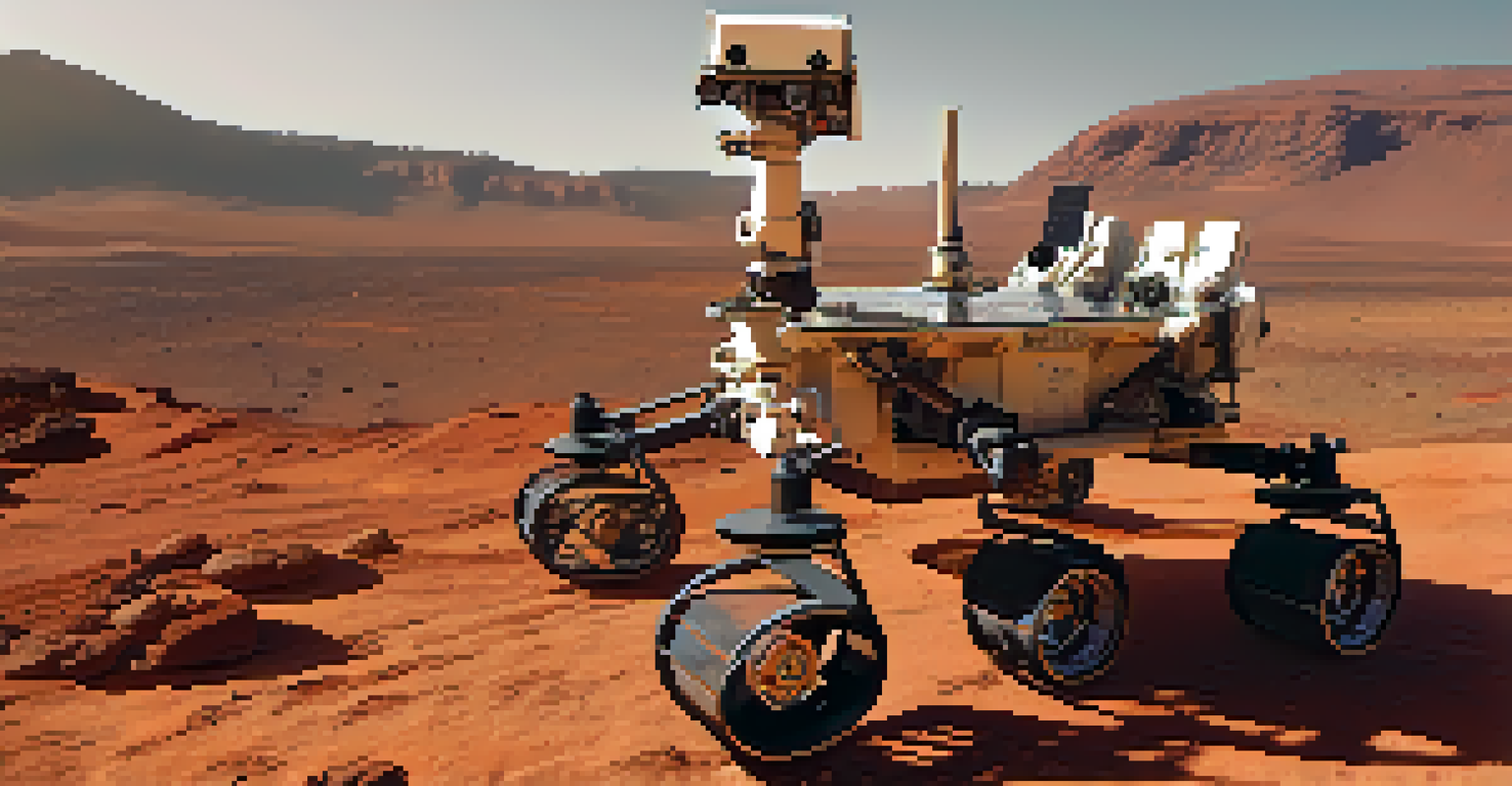California's Role in Advancing Space Technology and Research

California: The Heart of the Space Industry
California stands as a beacon for space exploration, housing major aerospace companies and research institutions. From the bustling streets of Los Angeles to the innovative campuses in Silicon Valley, the state is a hub for cutting-edge space technology. This concentration of talent and resources has fostered an environment ripe for collaboration and innovation, making it an epicenter for space-related advancements.
California is a place where dreams are pursued, and the impossible becomes possible.
Companies like SpaceX and NASA's Jet Propulsion Laboratory (JPL) have established their roots in California, drawing engineers and scientists from around the globe. These organizations are at the forefront of developing new technologies that push the boundaries of what’s possible in space exploration. The synergy between private enterprises and public institutions has created a unique landscape where ideas can flourish and transform into tangible projects.
Moreover, California’s universities, such as Stanford and Caltech, contribute significantly to research and development in space technology. They provide a steady stream of graduates equipped with the skills needed to tackle complex challenges in the aerospace sector. This academic prowess complements industry initiatives, ensuring that California remains a leader in the global space race.
Innovative Space Missions Led by California
California has been the launching pad for numerous groundbreaking space missions that have captivated the world. For instance, the Mars Rover missions, spearheaded by JPL, have not only expanded our understanding of the Red Planet but have also brought the excitement of space exploration into our living rooms. These missions showcase how California's technological capabilities can achieve what once seemed impossible.

The state is also home to the historic Voyager missions, which continue to send back valuable data about our solar system. Launched in the late 1970s, these space probes are now in interstellar space, providing insights into the universe that we never thought possible. Such achievements highlight California’s critical role in pushing the frontiers of human knowledge.
California: Space Innovation Hub
California serves as a central hub for space exploration, driven by a mix of major aerospace companies, universities, and government support.
Additionally, with the advent of commercial space travel, companies like SpaceX and Blue Origin are redefining the landscape. Their ambitious goals of making space more accessible to the general public have roots deeply planted in California's innovative spirit. This evolution not only inspires future generations but also opens up new avenues for research and development.
The Impact of Government Support on Space Research
Government support plays a vital role in California's advancements in space technology. Agencies like NASA and the National Oceanic and Atmospheric Administration (NOAA) provide funding and resources that empower researchers and engineers alike. These investments ensure that California can continue to innovate and lead in the space sector, sustaining its competitive edge.
The important thing is to never stop questioning. Curiosity has its own reason for existing.
Moreover, state initiatives and partnerships with local universities enhance the collaborative atmosphere necessary for groundbreaking research. Programs that encourage students to engage in space-related projects help cultivate the next generation of innovators. When the government backs such endeavors, it creates a ripple effect that benefits the entire industry.
The recent focus on sustainability and climate research has also driven California's space initiatives. Satellites developed in the state are essential for monitoring environmental changes, showcasing how space technology can address pressing global challenges. This alignment of interests further solidifies California's position as a leader in both space and environmental research.
Silicon Valley's Influence on Space Technology
Silicon Valley, often synonymous with tech innovation, has significantly influenced the space industry. The region’s culture of entrepreneurship and risk-taking has paved the way for numerous startups focused on space technology. These companies bring fresh ideas and approaches, complementing the work of established aerospace giants.
For example, companies like Planet Labs are utilizing small satellites to capture high-resolution images of Earth, providing valuable data for various sectors. This democratization of space technology allows more players to enter the field, leading to rapid advancements and novel solutions. The cross-pollination of ideas between tech and aerospace sectors creates a dynamic environment for innovation.
Groundbreaking Missions from CA
The state has launched numerous pioneering space missions, such as the Mars Rover and Voyager missions, showcasing its technological capabilities.
Furthermore, the collaboration between Silicon Valley firms and traditional aerospace companies fosters an ecosystem where ideas can be tested and implemented quickly. This synergy is crucial in addressing the fast-paced demands of space research and exploration, ensuring that California remains at the forefront of technological advances.
Public Engagement and Education in Space Technology
Public engagement is a critical component of California's approach to space technology. Initiatives that promote awareness and education about space exploration help foster a sense of curiosity and excitement among all ages. Events like the California Science Center’s exhibitions and public talks by scientists inspire the next generation of space enthusiasts.
Educational programs that partner with schools allow students to participate in hands-on activities, making space science accessible and enjoyable. These programs often include workshops, competitions, and field trips to leading space facilities, bridging the gap between theory and practice. Such initiatives not only educate but also encourage young minds to pursue careers in STEM fields.
By creating a culture that values space exploration, California ensures continued public support for research and funding. When communities are invested in the achievements of the space industry, it promotes a collaborative spirit that can lead to even greater advancements. This cycle of engagement and innovation is vital for the future of space technology.
California's Contributions to Global Space Initiatives
California's influence extends beyond its borders, contributing significantly to global space initiatives. The state collaborates with international space agencies, sharing knowledge and technology to tackle common challenges. Such partnerships enhance global efforts in space research, promoting a collective approach to exploration and discovery.
For instance, NASA's collaborations with European Space Agency (ESA) on missions like the Mars Sample Return highlight California's pivotal role on the world stage. These international projects not only showcase the state's technological expertise but also demonstrate the importance of cooperative efforts in advancing space science. Through these collaborations, California helps shape the future of space exploration for everyone.
Global Impact of CA's Space Tech
California plays a vital role in international space initiatives, collaborating with global agencies to address challenges like climate change through satellite technology.
Moreover, as a leader in satellite technology, California plays a crucial role in global communication and environmental monitoring efforts. Companies based in the state provide essential data that supports international initiatives aimed at tackling climate change and improving disaster response capabilities. This commitment to global cooperation emphasizes California's responsibility in using space technology for the greater good.
The Future of Space Technology in California
Looking ahead, the future of space technology in California appears bright. With ongoing advancements in rocket technology, satellite systems, and space exploration missions, the state is well-positioned to lead the charge into the next era of space research. The combination of public and private investment continues to drive innovation, ensuring that California remains at the forefront of the industry.
Emerging trends, such as the commercialization of space travel and interplanetary exploration, present new opportunities for growth. Companies are now setting ambitious goals, including manned missions to Mars and the establishment of lunar bases. These endeavors not only capture the imagination but also push the boundaries of what’s technologically feasible.

Additionally, as California embraces sustainability in space exploration, there’s a greater emphasis on responsible practices. This focus on environmental stewardship within the space sector reflects a broader commitment to addressing global challenges. As we move forward, California's role in shaping the future of space technology will undoubtedly inspire generations to come.